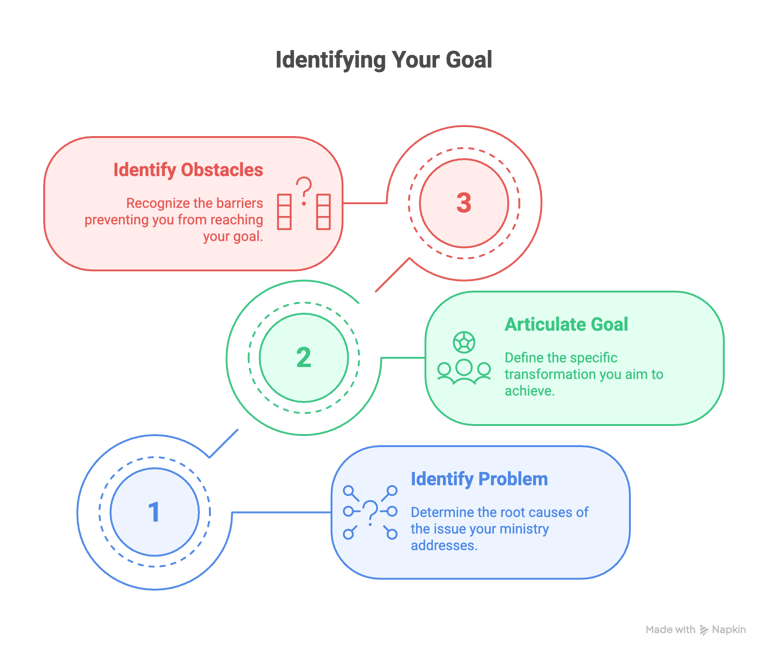6. Creating a Theory of Change Step 1: Identifying the Real Problem Your Ministry Exists to Solve
Brandon Booth
7/7/20256 min read
Never miss a post! Signup for my email updates today and get expert guidance delivered directly to your inbox!
Last week we bridged the gap between understanding heart change in general and building your specific Theory of Change. Now you're ready to start building your own Theory of Change, but where do you actually begin?
Today we'll tackle Step 1: identifying the real problem your ministry exists to solve and the specific change you want to create. Drawing from proven Theory of Change methodology, we'll walk through this crucial first step.
This might seem obvious, but many ministries have never clearly articulated their actual goal—and that's why they struggle to create lasting change. Let's start with the foundation.
Why Starting with Your Goal Matters
First, what is a goal?
Goals are ambitious, large-scale, significant changes you want to see happen in the future. They often include who or whatyou want to see change and describe the specific changes you want to see.
For example, you might want to see changes in individuals: "Help teenagers in our community develop a secure identity rooted in God's love for them." Or you might want to see changes in systems: "Transform how local churches approach mental health by building relationships with pastors and congregational leaders and providing them with quality counseling."
Many ministries start with activities, not goals:
They begin with "We want to run a food pantry" or "We want to start a youth center." But they've never clearly defined what change they're trying to create. This leads to busy ministries that struggle to know where to invest time and resources effectively.
If you don't know what transformation you're trying to create, how can you design effective strategies? How can you measure whether you're succeeding? How can you communicate your vision to others who might support your work?
A Theory of Change starts at the end:
This is called the backward mapping technique: Start with your desired end result, then work backward. This ensures everything you do connects to your ultimate purpose. It helps you distinguish between activities (what you do) and goals (what you want to achieve).
Instead of asking "What should we do?" you start by asking "What change do we want to see?" Then you work backward to figure out what activities and strategies will create that change.
Identifying Your Real Goal
Step 1: Identify the Problem You're Solving
What specific problem does your ministry exist to address?
This requires going deeper than you might initially think. You need to move beyond surface symptoms to identify root causes.
Go beyond surface symptoms to root causes: Don't just say "homelessness"—what's causing the homelessness you're addressing? Is it addiction? Mental health challenges? Lack of job skills? Family breakdown? Economic systems that don't provide living wages? Each of these root causes would require different strategies.
Be specific about your context: "Youth in our community lack positive adult mentorship" is much better than "youth need help." The more specific you can be, the more focused and effective your ministry will become.
Consider heart-level problems: Remember, you're not just solving practical problems—you're addressing heart issues that underlie them. This is what makes Christian ministry distinctive.
Example progression:
Surface: "People are hungry"
Deeper: "Families in our neighborhood struggle with food insecurity"
Heart level: "Families feel shame about their financial struggles and don't know they're valued by God"
Notice how each level gets more specific and moves toward the heart issues that Christian ministry is uniquely positioned to address.


Step 2: Articulate Your Goal (The Change You Want to Create)
What specific transformation do you want to see?
Now that you've identified the problem, you can articulate the change you want to create. This is where many ministries get stuck because they've never moved beyond thinking about activities.
Focus on people, not programs: Your goal should describe how people or systems will be different, not what activities you'll run. Instead of "We want to run a mentoring program," try "We want to help at-risk youth develop resilience and hope through meaningful relationships with caring adults."
Include heart transformation: Remember, your goal will involve heart change, not just behavior change. You're not just trying to modify external behavior—you're seeking heart transformation that leads to lasting change.
Be specific: "Help people experience God's love" is too vague. "Help single mothers experience God's delight in them and develop confidence in their parenting" is specific enough that you can recognize it when you see it.
Consider timeframe: Is this a 6-month goal? 2-year goal? Lifetime transformation? Different timeframes will require different strategies and measures of success.
Good goal examples:
"Help teenagers in our community develop a secure identity rooted in God's love for them"
"Help married couples experience renewed intimacy through encountering God's heart for their relationship"
"Help people struggling with addiction experience lasting freedom through heart transformation"
Notice how each of these goals is specific, focuses on people rather than programs, includes heart transformation, and is measurable (you'd know it if you saw it happening).
Step 3 Identifying Obstacles
What prevents the change you want to create?
Once you've identified your goal, you need to understand what's standing in the way. This is crucial because your strategies will need to address these specific obstacles.
External obstacles:
Lack of resources or funding
Community resistance or skepticism
Competing priorities in people's lives
Systemic issues (poverty, racism, inadequate healthcare, etc.)
Geographic or logistical barriers
Heart-level obstacles (most important):
Resistance to change: People's hearts resist direct efforts to change them. This is one of our key theological assumptions from Article 3.
Shame and guilt: These emotions close hearts and prevent openness to transformation. People who feel condemned are unlikely to seek help or be vulnerable about their struggles.
False beliefs about God: People may see God as demanding rather than loving, as distant rather than present, as disappointed rather than delighted in them.
Competing desires: Hearts may be captivated by other things—substances, unhealthy relationships, success, approval, control, etc.
Why identifying obstacles matters:
Your strategies need to address these specific obstacles. Different obstacles require different approaches. Understanding obstacles helps you set realistic expectations and prepare for challenges you'll face.
Example from Hope Recovery Ministry:
Problem: Substance addiction in the community
Goal: Help people experience lasting freedom from addiction
Obstacles: Shame prevents people from seeking help; hearts are captivated by substances rather than God; lack of supportive community; information-only approaches have limited success
Notice how this ministry identified both external obstacles (lack of community support) and heart-level obstacles (shame, competing desires). Their strategies will need to address all of these.
Your Next Step
Reflection Questions:
What specific problem does your ministry exist to solve? Go beyond activities to identify the real issue you're addressing.
What transformation do you want to see in people's lives? Focus on heart change, not just behavior change.
What obstacles prevent this transformation? Consider both external barriers and heart-level resistance.
Exercise 1: The Future Headlines Exercise
Imagine it's 3-5 years from now. Write newspaper headlines describing what your ministry has accomplished. What transformation has occurred in people's lives?
This exercise, borrowed from the Annie E. Casey Foundation's methodology, helps you think concretely about the change you want to create.
Exercise 2: The Problem Tree
Write your surface problem at the top
Below it, list the causes of that problem
Below those, list the root causes
Your goal should address the root causes, not just symptoms
This visual exercise helps you dig deeper into the real issues you're trying to address.
What's Next
Once you have a clear goal, you need strategies that will actually move you toward it—and not all strategies are created equal.
Next week, I'll show you Step 2: how to identify strategies that address your obstacles and connect to the heart-change principles we've discussed. We'll explore how to move from knowing what you want to achieve to developing specific approaches that can actually create that change.
Need help clarifying your ministry's goal and identifying the real problem you're solving? I'd love to help you think through this crucial first step. Getting Step 1 right sets the foundation for everything else, and sometimes it helps to have someone ask the right questions and help you dig deeper. Schedule a free 30-minute conversation with me, and let's work together to clarify the specific transformation God has called your ministry to create.
-------------------
This is the sixth article in our series "A Theory of Change: Building a Ministry that Actually Changes Lives!" ← See the previous article, or check out the next article here →


Let's build!
Connect with me today and let's start building your ministry that will change lives!
© Brandon Booth, 2025
Expert guidance for nonprofits and ministries.
Brandon Booth



